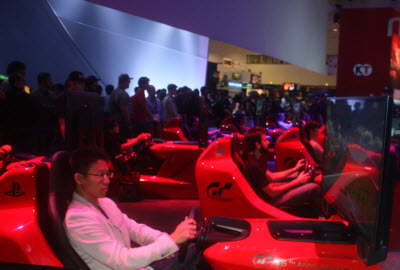LOS ANGELES — In the wake of the press conferences at the Electronic Entertainment Expo, Sony’s stock price rose this week and Microsoft’s fell. That says a lot about who did the best job of explaining their next-generation video game console to the public.
Jon Koller, Sony’s vice president of marketing of home console and handheld platforms, said all indicators suggest that Sony had a better show thanks to its surprise announcements that it would price its box at $399, or $100 cheaper than Microsoft’s, while it would permit gamers to sell used games without restrictions, once again in contrast to Microsoft’s position. But he knows Sony has a tough fight on its hands and wouldn’t presume to do a victory lap yet. We talked about the reactions to the E3 announcements and the big differences in strategy among the rivals.
Here’s our edited interview with Koller.
GamesBeat: What’s your take on the competitive picture that’s emerged here?
 Jon Koller: We came here with two things to do. One was to establish ourselves as for gamers and be focused on that. The second thing was to establish PlayStation 4 as the best place to play. I think we did both very well. Those were our objectives, regardless of what the competition did. I think it’s been a good E3 for us. Got a lot of work to go, though.
Jon Koller: We came here with two things to do. One was to establish ourselves as for gamers and be focused on that. The second thing was to establish PlayStation 4 as the best place to play. I think we did both very well. Those were our objectives, regardless of what the competition did. I think it’s been a good E3 for us. Got a lot of work to go, though.
GamesBeat: I was telling someone that if Microsoft makes the case that their machine and their system is better, it takes them a 30-minute infomercial. Sony right now can just do it in 30 seconds. “We have good games. We allow you to buy used games. Price is $399.”
Koller: One of the things that I think we’ve learned through the years is that the simpler and more focused approach is better, irrespective what Microsoft is doing on their marketing. For us, we look at how clean and simple we can make this. Can we make this as efficient as possible? The trend in the market is much more towards just making it easy for people.
We started working on the PlayStation 4 back in 2007. At the time, there were two things that stood out to us, and still do. That’s immediacy and accessibility. They’re the two key issues in this industry in general. This was before the rise of tablet and mobile. Those two things need to be solved. If you’re not clear about how you’re going to solve both of those things, then the gamer will react accordingly. I think you’re seeing some of that here this week.
GamesBeat: Was there an advantage in going after Microsoft’s event, or do you think you guys pretty much stuck to the gameplan as originally conceived?
Koller: We definitely stuck to the gameplan. It’s a strategy we’ve had for some time. We have had our price in place for a long time. We’ve had our used gameplan in place for a long time. The used gameplan, which a lot of people know about by now – a couple of your interviews even talked about it – is the fact that we want to make it as simple as possible. We don’t want to change what we think is a good system now with the current generation. We said, “It’s not broken. It’s working for us and for our partners. And gamers love it.”
If we have a stance, it’s for gamers. There’s really no other means by which we can change this. We looked at that as a foundation for us. So there wasn’t anything changed in that six-hour period between Microsoft’s press conference and ours, other than me being at the Microsoft press conference and seeing their price point and thinking, “Now we’ve got a tidal wave coming here in a few hours.”
GamesBeat: There are a few things people pointed out as diminishing some of that tidal wave a little bit. You’ll charge for multiplayer gaming on PlayStation Network. Maybe some publishers objected or something, but I guess there’s the asterisk that they could charge fees if they want to for used games. And the PS4 has no camera included, like the Xbox One comes with Kinect. I don’t know if that diminishes the argument or not.
Koller: We clearly don’t think so. On the camera, we wanted to be as open as possible and allow choice. One thing that we’ve tried to do throughout the history of PlayStation is give gamers choices. If you notice, we didn’t announce bundles. It’s a core [unit]. It’s $399. It comes with the console, HDMI cable, and a DualShock 4 controller.
The rest is up to the gamer – what games they want, if they want a camera, if they want another controller. We felt that was a better path. It by no means suggests that we’re diminishing the camera’s importance. The camera, as we showed in our announcement with games like Dream from Media Molecule, will be intrinsic to many experiences. But we want it to be up to the gamer to make that choice and see if they want to include it. It was our goal to get to that $399 price point. We felt that if we got there, we could have a real win. The freedom part, I think, was important.
On your second point, about publishers, we’ve now made it clear, but the system of online passes, charging for online play, is still available to publishers. That’s something they can still do. As a first party, we’ve said we’re not going to do it. But that port is open. What’s not open, and what we’re very clear about, is that we will not charge for offline gaming. That’s not something that we want to do. As the current system exists, it will transition in exactly that way to PlayStation 4.
Your first point, charging for multiplayer, we talked about a bit at the press conference. We’re building a network worthy of next-generation gaming. We view the network as critical, intrinsic to the experience. Again, we’re giving gamers choice. They don’t have to do this. We think that with all the features that are wrapped up into it — multiplayer gaming is part of it, but also instant game collection, sharing, the social experiences – there’s going to be a real consumer proposition. We’ve done a lot of research and testing into all of this. The feedback that’s come back says it’s a positive opportunity. I think that gamers appreciate what the network is going to be.
 GamesBeat: It wasn’t quite as much about bringing in a lot of the other innovations that have happened in the rest of the industry – online, mobile, social – this time around. I don’t know if you had already said a lot about that in February. This was mostly about games, but it would be interesting to hear more about some of these other things that are now possible, because you have Unity on the platform, or because you have Gaikai, or these other things.
GamesBeat: It wasn’t quite as much about bringing in a lot of the other innovations that have happened in the rest of the industry – online, mobile, social – this time around. I don’t know if you had already said a lot about that in February. This was mostly about games, but it would be interesting to hear more about some of these other things that are now possible, because you have Unity on the platform, or because you have Gaikai, or these other things.
Koller: There’s a lot more to talk about with PlayStation 4. This is one of those times when we’ve felt that we can give specific focused messages based on the venue and based on who’s listening. For the announce, we went with a heavier tech spec. We went with what our value proposition is. We showed some of the partnerships we have. There’s a lot of other things that will be announced at future opportunities. E3, we wanted to focus on gaming and have that be the key.
The last point I want to make on that is just—innovation, relative to PlayStation 4, there are obviously plenty of things to talk about in the future. There’s a lot in the works. But innovation, insofar as the way that publishers work with us, is one thing we tried to convey here at E3. Things have changed. In the past we would see development that was fairly agnostic. It was very much created across all the platforms at the time. It was up to the marketing teams to try to push that index rate one way or the other, based on a little bit of money that you’d put into the market.
It’s changing now. I think that you’ve seen things like what we did with Destiny, where there’s not necessarily exclusivity, but there are different types of gaming experiences – maybe hours of gameplay or different characters and whatnot – for the various games that we’re partnering with. Those things, we think, will end up influencing adoption on a longer-term basis and rolling up to the fact that we think the PlayStation 4 is the best place to play.

